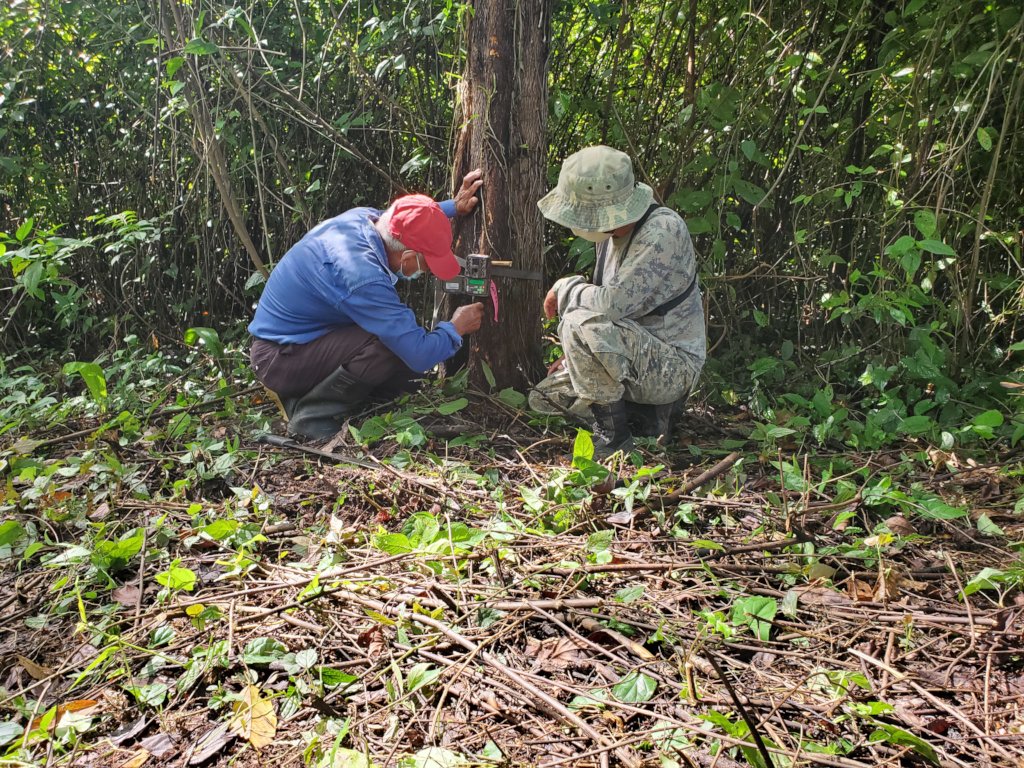By Diana Mai | Science Program Officer
With the support from the UK’s Kimbolton School, Ya’axché has been able to strengthen restoration efforts and camera trap-based biodiversity monitoring in and around the Maya Mountain North Forest Reserve (MMNFR). In conjunction with this conservation campaign, Kimbolton families, students, and faculty tracked their daily walking, running, swimming and biking mileage, and by the end of their spring break, they had cumulatively “traveled” the 5,250 mile distance between Kimbolton and Belize’s Maya Mountains. During their activities, they also learned about the actions taken by Ya’axché to help combat biodiversity and habitat loss in this southern Belize region known as the Maya Golden Landscape (MGL).
In terms of restoration efforts within MMNFR,Ya’axché has been experimenting in propagating valuable and threatened timber species native to regional forests, which include Vitex gaumeri (Walking lady), Swietenia macrophylla (Mahogany), Cymbopetalum mayanum (Anona de montaña), and Zanthoxylum spp (Prickly yellow).This is being undertaken at Ya’axché’s nursery, where germination and propagation is being monitored to determine the species’ ultimate success once replanted. Such experimental propagation and consequential data collection and analysis of seedling success will assist Ya’axché’s reforestation efforts across the MGL, including within protected areas like MMNFR.
Ya’axché is also working to ensure species biodiversity is maintained within MMNFR and the surrounding buffer community farmlands. Since 2016, Ya’axché has pictorially monitored biodiversity presence within local agroforestry efforts buffering MGL protected areas,starting with five agroforestry farmers, representing five buffering communities. In 2020, Ya’axché was able to expand its monitoring efforts, via camera traps, to include fourteen new farmers and three new MGL communities, thus allowing Ya’axché to study wildlife on a wider scale in the MGL.Monitoring wildlife in agroforestry farms buffering the MMNFR helps us understand how farmscapes provide connectivity as corridors and habitat for wildlife, thus contributing to biodiversity conservation locally within the MGL, regionally alongside our Central American neighbours and internationally. It is therefore imperative to continue to work with agroforestry farmers,as their farms serve the dual purpose of providing a haven for wildlife and maintaining habitat connectivity, while providing for their livelihoods through income generation and food security.
The result from the 2020 MGL agroforestry farm camera trap survey illustrated a strong presence of crucial predators and game species on these farms; thirty-five species of animals were recorded,including 20 mammals,14 birds and one reptile, including three of the five big cat species in Belize. With the expansion of the camera traps across new MGL farms, two new game species were recorded - the red-brocket deer and curassow -which were previously not recorded in four years of agroforestry monitoring, however are often recorded in protected areas such as MMNFR. Furthermore,Ya’axché observed a high correlation between farm location and protected areas,with higher species richness in farms neighbouring intact forests, compared to farms located in areas with high rates of deforestation.Recorded wildlife presence and abundance in protected areas such as MMNFR demonstrates the importance of the reserve to wildlife and highlights its designation as a Key Biodiversity Area, as well as illustrates the importance of wildlife monitoring in these farming systems as wildlife corridors and habitat for species.
Ya’axché has been working with these agroforestry farmers to enhance their skills in data collection, as these farmers are often the ones who monitor the camera traps and collect camera trap data, which consequently, enables them to see the wildlife utilizing their farms for habitat and travelling corridors.They are thrilled with the ease of camera operations and the marvelous wildlife capture on their farms. These agroforestry farmers become citizen scientists in their farms, and by extension their communities. This allows them to understand the importance of wildlife monitoring and ultimately become stewards of their natural resources. The photos from the camera trap data are utilized to print infographic guides for education and tourism purposes and provide valuable data about the species population on their farms which serves an incentive for farmers to continue monitoring and promote conservation and education of wildlife and their habitat surrounding MMNFR.
Ya’axché extends a heartfelt gratitude to the Kimbolton School students, families and faculty for their support which allows for restoration efforts and camera monitoring to continue within the biodiverse MMNFR and surrounding buffering communities.
Project reports on GlobalGiving are posted directly to globalgiving.org by Project Leaders as they are completed, generally every 3-4 months. To protect the integrity of these documents, GlobalGiving does not alter them; therefore you may find some language or formatting issues.
If you donate to this project or have donated to this project, you can receive an email when this project posts a report. You can also subscribe for reports without donating.


